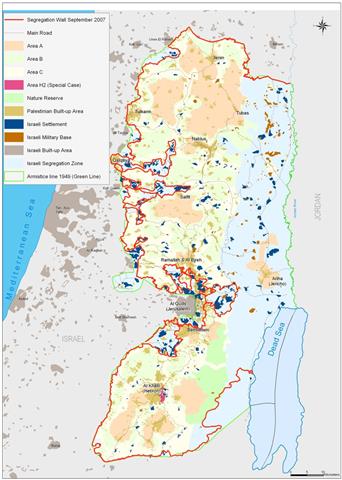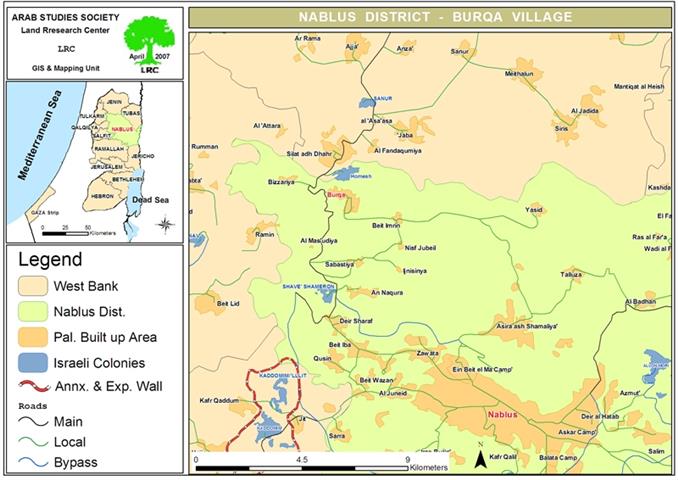Thursday 9 July 2010 marks the 6th anniversary of the International Court of Justice advisory opinion on the Legal Consequences of the Construction of the Wall in the Occupied Palestinian Territories. On 9 July 2004 the most authoritative legal body of the international community determined that construction of the wall violates international law. The Court ordered Israel to immediately stop construction of the wall, to dismantle those sections already built and to provide reparations for all damages caused by their construction. Today, on the occasion of the 6th anniversary of the findings of the Court, ARIJ wishes to highlight the continuing construction of the Segregation Wall by Israel and the continuing violations of international law, international humanitarian law and international human rights law resulting from the illegal construction.
Included in this brief, therefore, is not only a section on the background and legal findings of the 2004 ICJ advisory opinion, but also a section that outlines the current facts on the ground, which violate international law and continue to defy the 2004 ICJ findings. Indeed, these facts on the ground provide clear proof for how the Israeli government is continuing and reinforcing its regime of violations of the human rights of the Palestinian people through the continuing construction of the Segregation Wall.
International Court of Justice
The International Court of Justice’s role is to settle, in accordance with international law, legal disputes submitted to it by States and to give advisory opinions on legal questions referred to it. The United Nations General Assembly and Security Council may request advisory opinions on “any legal question”.
On 10 December 2003, the General Assembly submitted an official request to the International Court of Justice for an advisory opinion on the “security wall”. It is crucial to highlight that the advisory opinion wasn’t requested by a Palestinian or Arab entity, but rather by general consensus of the international community, as represented in the UN General Assembly. The question posed in UNGA resolution ES-10/14 was: What are the legal consequences arising from the construction of the wall being built by Israel, the occupying Power, in the Occupied Palestinian Territory, including in and around East Jerusalem, as described in the report of the Secretary-General, considering the rules and principles of international law, including the 4th Geneva Convention of 1949, and relevant Security Council and General Assembly resolutions.
Advisory Opinion
The advisory opinion declared that the occupying force (Israel) was taking illegal actions against the Palestinian people, their land and livelihood. The Court was not persuaded by Israel’s security argument of military necessity as it held that by constructing the wall, Israel is violating article 49 of the 4th Geneva Convention: ‘the Court is not convinced that the destructions carried out contrary to the prohibition in that Article were ‘rendered absolutely necessary by military operations’ so as to fall within the exception’.
In essence, the Court held the following:
1. The construction of the wall by Israel, the occupying Power, in the Occupied Palestinian Territory, including in and around East Jerusalem, and its associated regime, are contrary to international law.
2. Israel is under an obligation to terminate its breaches of international law; it is under an obligation to cease forthwith the works of construction of the wall being built in the OPT, including in and around East Jerusalem, to dismantle forthwith the structure therein situated, and to repeal or render ineffective forthwith all legislative and regulatory acts relating thereto.
3. Israel is under an obligation to make reparation for all damages caused by the construction of the wall in the OPT, including in and around East Jerusalem.
4. All States are under an obligation not to recognize the illegal situation resulting from the construction of the wall and not to render aid or assistance in maintaining the situation created by such construction; all States parties to the Fourth Geneva Convention relative to the Protection of Civilian Persons in Time of war of 12 August 1949 have in addition the obligation, while respecting the United Nations Charter and international law, to ensure compliance by Israel with international humanitarian law embodied in that Convention.
5. The United Nations, and especially the General Assembly and the Security Council, should consider what further action is required to bring to an end the illegal situation resulting from the construction of the wall and associated regime, taking due account of the present advisory opinion.
Facts on the Ground
Even after 6 years, Israel continues to defy the advisory opinion of the International Court of Justice. Not only have the Israeli authorities not dismantled already built sections of the wall, they have even increased the length of the wall (as shown in table 1 below) and as such have planned and implemented plans for continuous land grab and segregation.
Table 1: Changes in the Segregation Wall Route between June 2004 and April 2007
|
Date of Change
|
Wall Length (km)
|
Area Isolated (Km2)
|
% of Land Isolated in the West Bank
|
|
June 2004
|
645
|
633
|
11.2
|
|
February 2005
|
683
|
565
|
10
|
|
April 2006
|
703
|
555
|
9.8
|
|
April 2007
|
774
|
733
|
13
|
Source: Applied Research Institute – Jerusalem, 2010
On June 2002, the Israeli Government launched its policy of unilateral segregation within the Occupied Palestinian Territory (OPT) by establishing a Segregation Zone along the western terrains of the occupied West Bank. The Western Segregation Zone is the area west of the Segregation Wall that reaches to the Green Line.
In September 2004, the Israeli Army issued military orders, creating a buffer zone averaging 150-200 meters in width on the Palestinian side of the Western Segregation Wall where new Palestinian constructions are prohibited. As a result, an additional 254 Km² of the West Bank (4.4%) will become inaccessible to Palestinians. On February 20, 2005, the Israeli Government published a revised route of the Western Segregation plan, where the Wall runs for 683 Km into the West Bank. Only 138 Km (20.2% of the total length) ran on the Green Line (the 1949 Armistice Line). When completed, 576 Km² of Palestinian lands (10% of the total West Bank area) situated inside the Western Segregation Zone are set to be isolated from the rest of the West Bank territory.
On 12 September 2007, the Israeli Ministry of Defense published on its website ‘Israel Security Fence’ a plan for a new revised route for the Segregation Wall showing an increase in the Wall’s length and lands isolated compared to what was published in April 2006. The updated map that was actually endorsed back in April 2007 was only displayed on the website in September 2007. Apparently, there was no plan to make the map public, as the map of the new Wall route was retracted from the website a few days later.
According to the latest wall update, an increase of 32% (178.000 thousands Dunums) has been planned to be further isolated between the 1949 Armistice Line and the line of Segregation Wall. This represents a change from 555 km² isolated in 2006 to 733 km² (733 thousands Dunums/ 73300 hectare) isolated in 2007, 13% of the total area of the West Bank. Table 2 shows classification of isolated Palestinian land within the western Segregation zone:
|
Table 2: Western Segregation Zone (733 km2) Land use/ Land cover
|
|
Item
|
Area/ km2
|
percentage
|
|
Agricultural Land
|
348
|
47.5
|
|
Israeli settlements & military bases
|
110
|
15
|
|
Forest and open space areas
|
250
|
34
|
|
Palestinian built-up area
|
25
|
3.5
|
|
Total
|
733
|
100%
|
Source: Applied Research Institute – Jerusalem, 2010
Map 1: The Israeli Segregation Wall map of April 2007
The Israeli Segregation Wall and the Advisory Opinion
The Segregation Wall snakes around the Occupied Palestinian Territory, encircling Israeli settlements, and cuts deep into Palestinian lands. According to the Palestinian Liberation Organization, the wall is ‘an attempt to annex the territory contrary to international law’. Furthermore, the PLO argues that such ‘de facto annexation of land interferes with the territorial sovereignty and consequently with the right of the Palestinians to self-determination’ (see para 115 of Advisory Opinion).
In its advisory opinion, the ICJ followed the PLO’s position as it declared: ‘The Court considers that the construction of the wall and its associated régime create a ‘fait accompli’ on the ground that could well become permanent, in which case, and notwithstanding the formal characterization of the wall by Israel, it would be tantamount to de facto annexation’ (see para 121). On the issue of Palestinian self-determination, the Court unequivocally stated that ‘the route chosen for the wall gives expression in loco to the illegal measures taken by Israel with regard to Jerusalem and the settlements, as deplored by the Security Council (…) That construction, along with measures taken previously, thus severely impedes the exercise by the Palestinian people of its right to self-determination, and is therefore a breach of Israel’s obligation to respect that right’ (see para 122).
The Israeli Western Segregation Zone covers substantial and significant land areas, rich with natural resources (water aquifers) as it runs along the western part of the West Bank from north to south, seizing the most fertile agricultural lands, isolating Palestinian communities in enclaves, undermining the territorial contiguity between Palestinian villages and cities, controlling the natural resources, and encapsulating and protecting most of the illegal Israeli settlements.
The Wall separates 107 Israeli settlements (accommodating 80+% of the Israeli settlers’ population in the West Bank) and 66 Palestinian localities (including 30 in Jerusalem) from the West Bank. These 107 settlements, built on confiscated Palestinian land, will lie on the Israeli side of the Wall and will have easy access to locations within Israel. The 66 Palestinian localities (excluding the 30 Jerusalem localities) on the other hand will be cut off from the West Bank and will not have access to Israel on the western side. These localities will thus be isolated in the Western Segregation Zone.
In essence, the Segregation Wall cuts Palestinian land into separate discontinuous pieces and virtually diminishes the chances for a future viable Palestinian state. As such, the Segregation Wall denies the Palestinian people their inherent right to self-determination.
To date, the 2004 authoritative decision of the ICJ has been blatantly ignored not only by Israel, but also by the international community. The advisory opinion declared that third states are under an obligation not to recognize the illegal situation resulting from the construction of the wall and not to render aid or assistance in maintaining the situation created by such construction. On the sixth anniversary of the advisory opinion, ARIJ requests that the international community exert pressure on Israel to stop the construction of the Segregation Wall. Furthermore, ARIJ requests that the international community advocates for the complete removal of the Wall from the OPT, as the continuing construction of the Segregation Wall violates fundamental human rights of the Palestinian people, including their inherent right to self-determination.












